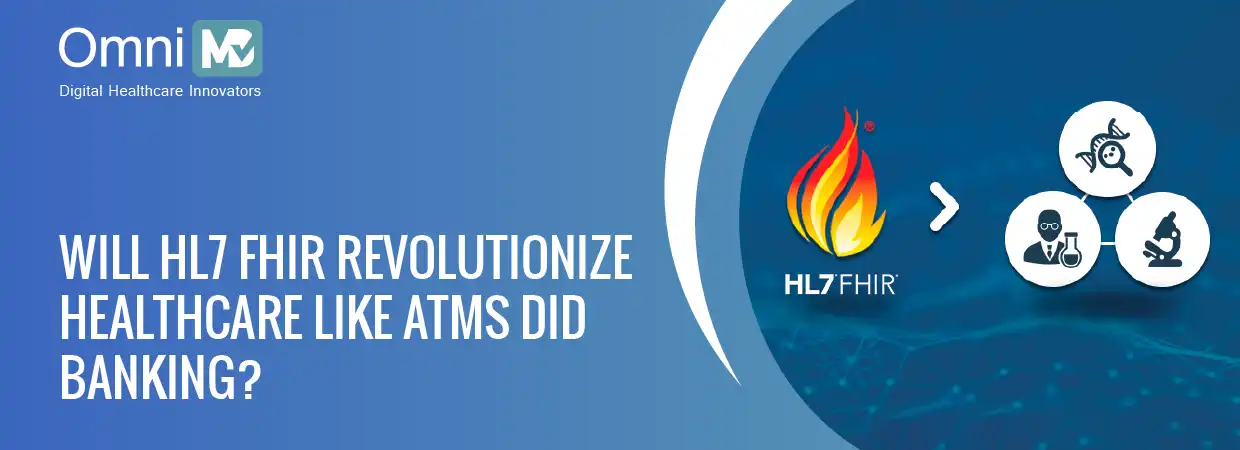Will HL7 FHIR Revolutionize Healthcare Like ATMs Did Banking?
In 1967, inspired by a chocolate-vending machine, John Shepherd Barron introduced the Automated Teller Machine (ATM), which changed the banking industry forever.
A similar kind of revolution occurred in 1989, when the healthcare system’s first and most widely accepted HL7 version, V2, was introduced to ensure interoperability. It standardized medical data formats, enabled providers to make informed decisions, improved patient care, reduced administrative burden, and helped them comply with state and federal government guidelines.
What is HL7, and Why Do Medical Entities Need It?
HL7 is established by Health Level Seven International, a not-for-profit standard-developing organization. It is accredited by the American National Standard Institute (ANSI) and is responsible for creating globally accepted standards for exchanging, integrating, and retrieving healthcare data.
The healthcare industry is surrounded by an ever-increasing mountain of data and relies heavily on software to run its operations. From scheduling an appointment to tracking medication progress and extracting actionable insights on medical care satisfaction, clinics utilize platforms like EHR, PMS, patient engagement tools, and telemedicine.
These diverse software systems need to communicate seamlessly with one another to deliver efficiency, accuracy, and medical proactiveness, and HL7 equips them to do so in the most convenient way.
Before HL7, IT systems used to act independently, sharing information manually in their own distinctive language and data formats. HL7 provides a universal healthcare IT language that most software speaks. It gives frameworks that guide how clinical data is collected, processed, and shared among various healthcare providers or within different IT systems of the same organization.
In essence, HL7:
- Suggests ways to automate standard workflows
- Guarantees data is accessible, usable, and reliable
- Maintains consistency in data formats and content
- Prevents data fragmentation or loss
- Ensures interoperability
How did HL7 Evolve into The Existing HL7 FHIR?
In 1987, Health Level Seven International (HL7) was founded to establish guidelines for healthcare data interoperability. In 1989, it released its first version, HL7 V2, to facilitate electronic exchange of clinical information, which became hugely popular for its ease of use.
Over time, to accommodate the evolving needs of healthcare entities, HL7 V2 introduced several feature enhancements while maintaining backward compatibility. Some of the versions include HL7 V2.3, HL7 V2.4, HL7 V2.5, and HL7 V2.7.
However, as healthcare data complexities increased, HL7 V2 faced challenges such as inconsistency in implementation across different systems and inadequate support for intricate data structures.
To address these issues, HL7 released V3, which utilized a formal methodology known as the Reference Information Model (RIM) and XML for message encoding instead of a text-based format. Yet, due to its lack of backward compatibility and steep learning curve, it did not gain widespread adoption among healthcare entities.
In the 2000s, HL7 released CDA (Clinical Document Architecture), a part of HL7 V3 to offer a more simplified way to handle clinical documents, but it too encountered difficulties in fitting into many workflows and was challenging to extend.
Thus, to overcome the limitations of V2, V3, and CDA, and leverage the best of modern web technologies, HL7 developed FHIR (Fast Healthcare Interoperability Resources).
| Parameter | HL7 V2 | HL7 V3 | CDA | FHIR |
| Basic Structure | Message-oriented. | Object-oriented messages (using XML). | Document-based exchange (XML documents). | Resource-based architecture (RESTful API). |
| Learning | Moderate. Requires knowledge of segments like MSH, PID. | Steep. Detailed XML schemas and specifications. | Moderate. Focuses on XML and document structures. | Easy. User-friendly with resources like JSON, and XML. |
| Platforms Support | Limited, legacy systems like mainframes. | Limited, specialized systems with XML support. | Limited, in specific EHR systems. | Extensive, supports modern web technologies (Java, .NET, Python). |
| Extensibility | Limited. Hard to adapt. | Moderate. Some customizations via XML. | Moderate. Customizable within document templates. | High. Easily extendable using profiles, and extensions. |
| Security | Basic features. SSL/TLS for transmission. | Basic features. Uses XML security. | Basic features. Relies on document security measures. | Advanced. OAuth, SMART on FHIR, modern protocols. |
| Code Systems | Limited. Uses HL7 tables, and local codes. | Standardized but limited. HL7 tables, LOINC, SNOMED CT. | Limited. Often needs additional coding systems. | Extensive. Supports LOINC, SNOMED CT, ICD-10. |
| Required Tools | Custom tools like Mirth Connect, and Interface Engines. | Custom tools for XML processing, XSLT. | Custom tools for document creation, and handling (OpenMRS, LOINC tools). | Standard tools (e.g., RESTful APIs, Postman, FHIR servers). |
| Adoption and Usage | High in legacy systems, hospitals. | Moderate. In complex systems, and regulatory environments. | Moderate. For document exchange in healthcare. | High in modern systems, health tech startups, and EHR vendors. |
| Interoperability | Moderate. Needs customization (interface engines). | Moderate. Better than V2 but complex. | Moderate. Document-based interoperability. | High. Designed for seamless integration, uses REST. |
| Reliability | Reliable in legacy systems. Stable. | Moderately reliable. Complexity can be a barrier. | Moderately reliable. Dependent on consistent document handling. | Highly reliable. Modern tech ensures robustness. |
| Flexibility | Limited. Old architecture. | Moderate. Adaptable within XML framework. | Moderate. Document-based flexibility. | High. Flexible with resources, profiles, extensions. |
| Compatibility | Limited, older systems. | Better than V2 but restricted. | Limited, document-based systems. | High with modern technologies. Web-based systems. |
| Implementation Cost | Low. Widespread legacy use. | Moderate. Complex, requires expertise. | Moderate. Based on document exchange. | Moderate. Tool support, ease of use balance cost. |
An Overview of How HL7 FHIR Works
Designed to respond to the growing complexities of medical data, user expectations, and the rising ‘app’ economy in smartphones, FHIR (Fast Healthcare Interoperability Resource) uses APIs that pull data from multiple sources and place it in a primary operating system accessible to the majority of organizations within the healthcare system.
Let’s understand this through a scenario. Imagine a healthcare provider developing an app specifically for patients with chronic conditions like diabetes or heart disease. Designed with the FHIR communication standard, the app consistently integrates data from glucose monitors, fitness trackers, and electronic health records. The achieved interoperability benefits patients like Sarah, who are managing diabetes and hypertension. It automatically syncs her glucose readings, physical activities, and health records, providing real-time updates to her healthcare providers. This allows for proactive adjustments to her treatment plan, ensuring better management of her conditions and more.
FHIR and Its Application in Healthcare IT
Due to its ability to fix real-time medical care expectations, FHIR quickly garnered support from key healthcare players. We have highlighted some of the most notable case studies below, showcasing the implementation of FHIR in improving interoperability, enhancing patient data management, and driving innovative healthcare solutions.
Pfizer and Ochsner Liberated Clinical Trials
Pfizer Inc., a multinational biopharmaceutical company, and Ochsner Health, a not-for-profit academic healthcare system, entered a multi-year strategic alliance to make clinical trials easier and more accessible to patients, providers, and researchers.
Since its inception, integrating EHR data with clinical trial databases has faced enormous challenges due to inconsistencies in technology platforms and data standardization. They often required manual data entry or third-party software. To address this, Pfizer and Ochsner leveraged FHIR services to build a digital tool that uniformly integrated Ochsner’s EHR data into Pfizer’s clinical trial capture system. It also helped assemble clinical trial data from other healthcare systems and providers.
This not only reduced administrative burden and errors but also encouraged patients to participate in clinical trials, providers to manage clinical trials efficiently and researchers to gather data more accurately.
Download the full case study here.
Humana Took FHIR to Cloud
Like any large enterprise, Humana, the American Health Insurance company, had legacy technologies for storing data and wanted to modernize them. The aim was to create a central data repository powered by interoperability.
The company took a cloud-based approach and used FHIR to ensure smooth bidirectional data communication. Being one of the first healthcare insurers to implement FHIR fully, Huaman started to see more value-based and personalized patient care right away with robust real-time access to healthcare information.
Download the full case study here.
Geisinger Optimized Its Family Care Application (FCA)
Geisinger, a nonprofit healthcare and wellness organization serving central, south-central, and northeastern Pennsylvania, aimed to optimize its FCA to secure more effective and comprehensive communication between caregivers and the care team (providers, nurses, etc.).
To achieve this, Geisinger upgraded its app’s API from a standard EHR web service to HL7 FHIR, allowing the app to pull data from various sources such as EHR, wearable devices, lab technicians, etc.
Also, with the upgrade, both caregivers and providers have crucial health information, such as tests and investigations, medical history, e-prescriptions, etc, at their fingertips. This entrusted them with the ability to make informed decisions and deliver better patient outcomes.
Download the full case study here.
Summing Up
Currently, 95% of U.S. healthcare uses HL7 V2 as a standard for interoperability. But deciding which one to use must be based on your organization’s IT architecture and data-sharing needs. FHIR would be a suitable fit if you are open to innovation. However, if you are looking for legacy standards, then HL7 V2 is the right option.
Being in the healthcare IT industry for more than two decades, we recommend FHIR because:
- It is more convenient and compatible than V2
- Offers components that can be used to build custom software
- Provides engineers with flexibility in tech solutions and decision-making
- The resources required for its implementation are freely available
- Helps ensure data security and privacy along with interoperability

Best EHR Software for Your Clinic
Streamline your clinical practice and improve patient care effortlessly

 Written by Neha Singh
Written by Neha Singh
 Reviewed by Shivani Joshi
Reviewed by Shivani Joshi